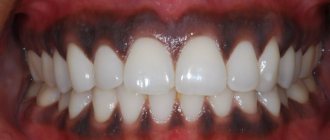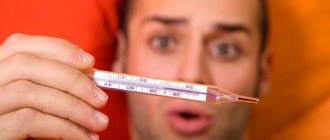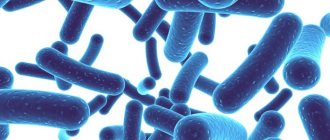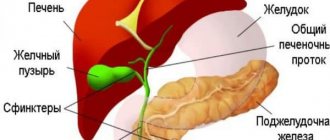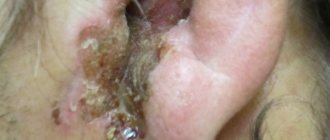The main factors that provoke changes in the color of stool
The norm is to have a bowel movement every 1-2 days, and the color of the feces should be brown. What could cause a slight deviation from accepted standards?
There are a number of physiological and pathological factors:
- Eating food that affects various processes in the body or contains a large amount of coloring substances.
- Imbalance of the body's bacterial environment, infectious disease, poisoning, allergic reactions, development of pathologies of internal organs, in particular those related to the digestive tract.
- Taking certain medications.
Changes you shouldn't worry about
Fans of sweets, such as marmalade, jellies and other foods high in dyes, may periodically notice greenish stools.
In addition, other foods affect the color of stool:
- If you eat a lot of meat, your stool may appear dark brown.
- If the diet is dominated by plant components or dairy products, the feces lighten, acquiring a yellow tint.
- The black-brown color is typical for lovers of blackcurrants and blueberries.
- Burgundy feces are obtained after eating raspberries and beetroot.
- A dark green tint occurs if a person eats sorrel or spinach salad. The same reaction of the body occurs to the consumption of cereals. Long-term preservation of green stool is possible in people following a plant-based diet.
- Legumes and red meats are high in iron, which turns stool black-green.
Change in stool color when taking medications
Feces may turn green when consumed:
- Iodine preparations.
- Laxatives, in particular herbal medicines.
- Sorbitol.
- Glucose.
- Chlorophyll.
- Vitamin complexes.
- Iron-containing preparations.
- Medicines based on seaweed.
Usually, a possible change in the color of feces is mentioned in the annotation for the medicine. If such drugs are discontinued, within 5 days the stool acquires a characteristic dark brown tint. If you take a radiopaque substance, the stool may become gray, but after 2-3 days the condition will normalize on its own.
Antibiotics, when used for a long time, disrupt the intestinal microflora, causing dysbacteriosis, which entails a change in the normal color of stool to green.
Consequence of the development of a pathological environment
Feces in an adult can acquire a peculiar shade when gastrointestinal diseases appear.
Most often diagnosed:
- Dysbacteriosis. Due to an imbalance of intestinal microorganisms, the process of food digestion is disrupted, food leftovers rot, which may be accompanied by a disturbance in the frequency and color of stool.
- Dysentery. The condition is characterized by acute abdominal pain, diarrhea, nausea and vomiting. The patient becomes weak and the temperature rises sharply.
- Salmonellosis. Once in the body, an intestinal infection causes a sharp rise in temperature, nausea, vomiting, abdominal pain, and diarrhea.
- Rotavirus infection. The stool has a liquid consistency mixed with mucus and an unpleasant odor. The patient exhibits signs of intoxication, weakness and a sharp rise in temperature.
- Enteritis. The inflammatory process in the intestines is manifested by diarrhea, nausea, pain in the abdominal area, and weakness.
- Tumors of various etiologies, internal bleeding or complications of an ulcer. The green color occurs due to the oxidation of iron in red blood cells.
- Diseases of the circulatory system. When decaying red blood cells begin to produce insufficient amounts of bilirubin from hemoglobin, there is not enough pigment to color the feces, and they are excreted in a permanent green color. Liver problems, such as hepatitis, also lead to the same consequences.
With infectious lesions of the intestines, a bright green tint to the stool, a rise in temperature, weakness and an admixture of mucus in the stool are observed. In case of poisoning, these symptoms include vomiting and severe abdominal pain .
Allergies to foods can be manifested by a change in the color of the stool, along with the presence of mucus and undigested food debris. If you are gluten intolerant, you will experience runny stool with an unpleasant odor. And lactose indigestion is characterized by the onset of diarrhea with green stool immediately after consuming dairy products.
In babies under 6 months of age, green stool may indicate increased bilirubin. At this age, the condition can normalize on its own.
Often a change in shade is associated with a transition to a different mixture. This occurs due to the immaturity of the digestive system. The food of the breastfeeding mother also plays a role in many respects, since all substances from the products penetrate into the milk.
Causes of green stool
Normally, stool is brown in color. This color is provided by bile pigments. With normal functioning of the digestive system, stool is formed and has a solid consistency.
Remember that any change in consistency or color of poop has a reason. But its appearance can be influenced by many factors. If there is a long-term change in the type of stool, you should consult a doctor.
An adult may develop green stool for the following reasons:
- Eating foods that affect stool color. This could be green peas, herbs, vegetables, or foods treated with green dye. If the cause of green stool is food, it has a formed and solid consistency and does not have a pungent and fetid odor. The appearance of such stool is not accompanied by any other symptoms. Diarrhea, abdominal pain and hyperthermia are not typical for this condition.
- Salmonellosis. This disease belongs to the group of intestinal infections. It can develop after eating contaminated eggs, meat or dairy products. Salmonellosis can also be contracted from a person who is sick with it. This disease is characterized by diarrhea, fever up to 38-39 degrees, abdominal pain, nausea and vomiting. Yellow or green loose stools due to salmonellosis can lead to severe dehydration in a short period of time .
- Inflammatory diseases of the digestive tract (ulcerative colitis, Crohn's disease). The swampy color of the stool in these pathologies is provided by leukocytes, cells that are present in areas of inflammation. With these pathologies, body temperature may rise and abdominal pain may develop.
- Lactose intolerance. With this disease, the human body does not have an enzyme that digests dairy products. At the slightest use, loose, light green stool appears. Stool may also have a normal color. A person who has this pathology knows about it and is not surprised to see changed stool after violating the diet prescribed by the doctor.
- Gastrointestinal bleeding. We all tend to think of this condition as having black stools, but they can also be dark green in color. This shade is provided by hemoglobin that comes into contact with gastric juice. With gastrointestinal bleeding, black vomiting may also appear, the pulse quickens, blood pressure rapidly decreases, and general weakness and pallor of the skin develop .
What color of stool indicates disease of the internal organs?
Many people do not know what diseases cause the color of feces to change. It should be noted that these are mainly pathologies of the pancreas, liver, gallbladder, stomach and intestines.
- Green feces may be a consequence of intestinal inflammation or the development of a tumor of this organ, intoxication of the body, or celiac disease.
- Red-brown indicates the presence of minor internal bleeding in the lower digestive tract. Observations show that this means damage to the intestinal walls. When feces move through the intestines, the mucous membranes are injured, blood is released through small cracks and enters the feces.
- Black may indicate bleeding in organs located in the upper digestive system.
- Yellow-green indicates carbohydrate fermentation. This condition occurs with diseases of the pancreas, for example, diabetes.
- Gray-green or white indicates a lack of bile entering the intestines. Pathology occurs when there is liver disease and when the gallbladder has stones or a tumor that blocks the excretory ducts.
Symptoms associated with green stool
If the color change occurs due to taking medications or triggering foods, then no other signs of the disease occur. When the problem is caused by the ingress of pathogenic microorganisms, the development of ailments of internal organs, hidden bleeding, the following symptoms occur simultaneously with green feces:
- Abdominal pain. Usually its location indicates the location of the diseased organ.
- Nausea and vomiting.
- Diarrhea.
- Unpleasant smell of stool.
- The presence of mucus or blood in the stool.
- Fever.
- General deterioration in health: headache, dizziness, weakness, fatigue.
Noticeable change in stool color and nausea
Any change in the color of stool raises questions. This symptom is especially suspicious in combination with nausea and vomiting. Usually the cause of this phenomenon is considered to be an intestinal infection. It is also accompanied by high fever and weakness .
If you do not take into account the color of the stool, the symptoms are similar to ordinary intoxication, therefore, if you find such symptoms, carefully study the color of your stool to rule out acute intestinal infection , which can lead to complications.
When the diagnosis is confirmed, it is necessary to undergo special treatment, since during illness the body loses a lot of fluid.
The installation of IVs with saline and glucose solution is required. The attending physician also prescribes special medications.
This problem can occur in both adults and children.
Green stool in pregnant women
Expectant mothers try to monitor their diet, so they eat large amounts of plant foods. Spinach and broccoli contain chlorophyll, which can cause stool to change color.
In addition, to prevent anemia and bone destruction during pregnancy, vitamin complexes rich in iron and calcium are prescribed. Also, black feces can be a consequence of taking activated carbon during gas formation.
Dysbacteriosis is a frequent companion of pregnant women. In this case, diarrhea begins and the stool is green.
When this diagnosis is made, the doctor prescribes Smecta or Imodium to remove toxins. It is recommended to include whole grain cereals, fermented milk products, and green tea in your diet.
In order to prevent serious complications during the period of bearing a baby, in case of any disturbances or changes in the color and consistency of the stool, you should consult a doctor.
Causes of green stool in adults
A green tint to feces is common during the summer months when people eat large amounts of plant foods. If the feces of a newborn baby acquire a black-green hue, in the first month of the baby’s life this circumstance can be considered the norm. Subsequently, the feces become dark olive, and later light brown. If the child's condition is not alarming, these changes are not unusual.
In contrast, a green tint to feces in an adult is a prerequisite for serious illness. Dark green stool may be a symptom of gastrointestinal bleeding due to peptic ulcers in these parts of the gastrointestinal tract. If complete oxidation of blood hemoglobin occurs, the stool turns black.
Additional symptoms of bleeding:
- Anemia,
- Frequent pulse;
- Pallor;
- Dyspnea;
- Weakness.
Green stool may appear due to dysentery, an intestinal infection that is treated in a hospital under the guidance of an infectious disease specialist.
Additional symptoms of dysentery:
- Weakness;
- Nausea and vomiting;
- Hyperthermia;
- Severe pain in the epigastric region.
Dysbacteriosis can also cause green stool. With this pathology of the small intestine, the death of lacto- and bifidobacteria occurs, which provokes fermentation and rotting of food. The human body is trying to cope with the disease; dead leukocytes accumulate in the gastrointestinal tract. This circumstance gives the stool a green color. Similar phenomena occur in stool as a result of long-term use of antibacterial agents.
In liver pathologies and blood diseases, hemoglobin red blood cells break down, producing excess bilirubin. It turns the patient's feces dark green.
Diseases that cause changes in the color and consistency of stool:
- Salmonellosis,
- Reflux esophagitis,
- Diabetes,
- Crohn's disease,
- Ulcerative colitis,
- Food poisoning
- Allergy to lactose and fructose;
- Pathologies of the endocrine system (thyroid gland);
- Inflammation of the small intestine.
To clarify the pathology that caused changes in stool, the results of a stool analysis are not enough. Most likely, the doctor will prescribe an additional examination to help determine the characteristics of the disease.
First aid at home
If the color of stool changes, you should reconsider your diet, excluding sweets and foods rich in chlorophyll and containing dyes from the menu.
If you have diarrhea, you must take Smecta or Regidron. This will normalize water and electrolyte balance and avoid dehydration.
Atoxyl is an excellent sorbent that is used to remove toxins, especially during vomiting. But the drug should be taken after gastric lavage.
In cases of severe dysbiosis, it is useful to take probiotics . If improvements are not observed within several days or the condition is accompanied by a rise in temperature, bloody stools, nausea, vomiting and diarrhea, you should consult a doctor.
After conducting a series of tests, the specialist will make a diagnosis and prescribe appropriate treatment. These can be anti-inflammatory, antibacterial drugs, antispasmodics, vitamin complexes. In case of internal bleeding, urgent hospitalization followed by surgical intervention is indicated.
Examinations for green stool in adults
Green feces in an adult for a long time is a reason to visit a gastroenterologist to find out the causes of this condition. If the symptom is accompanied by high fever, intoxication and acute pain, you should contact a specialist immediately. To make a diagnosis, depending on the manifestation of additional symptoms, doctors use the following hardware and laboratory tests:
- general analysis of urine and blood;
- microscopic examination of stool;
- bacteriological examination to identify the causative agent of infection or determine the state of the intestinal microflora;
- colonoscopy;
- gastroscopy;
- MRI or CT scan of the abdomen.
There is no need to panic if you periodically observe green stool during bowel movements. In most cases, there is a simple explanation that is not related to health problems. Green stool is generally within the range of normal stool color. The green color of stool is most likely due to the foods that were eaten or the vitamins or supplements that were taken over the past few days - even if these drugs or foods themselves are not green in color.
Purple, black, or other dark colors in foods can also affect the color of stool, making it appear green. But green diarrhea, especially if it continues for several days, should alert you. In this case, it is better to consult a doctor.
Tests to determine the cause of change in stool color
To make a correct diagnosis when green feces appear when they are not associated with food intake, you should undergo a series of examinations:
- General blood test with determination of the leukocyte component.
- Analysis of urine.
- Blood test for biochemistry and electrolytes.
- Analysis of stool for bacterial environment.
- Ultrasound of the abdominal cavity.
- ECG.
If there are appropriate indications, gastroscopy, colonoscopy, CT or MRI of the abdominal cavity may be prescribed.
The green color of feces, like other uncharacteristic shades, can be the result of a number of pathologies. To determine the cause and exclude the presence of the disease, you should promptly consult a doctor and do the necessary tests. Self-medication can worsen the situation, lead to dehydration and damage to internal organs.
vseozhivote.ru
Diagnostic features
When green stool appears, the doctor usually prescribes the following diagnostic procedures:
- coprogram - a laboratory test in which you can study the chemical composition of stool. In most cases, coprogram is sufficient to identify the exact cause of the change in stool color;
Coprogram - example results - bacterial culture . Another test with which a doctor can determine the causative agent of an intestinal infection, assess the state of the microflora, and also detect pathogenic microorganisms, if any. During the procedure, the biomaterial is placed in a special habitat, after which it becomes possible to determine the pathogen;
- microscopic examination . It is prescribed in cases where the presence of parasites is suspected. During diagnostic testing, doctors use polymer chain reaction, which isolates life-cycle DNA.
Stool analysis
As an addition, the doctor may prescribe other laboratory tests, including blood and urine tests. Based on the results obtained, an accurate diagnosis is made.
Causes of green stool in adults
Among the main causes of green stool in adults, two can be distinguished: bile and food (food coloring, medications, dietary supplements). Let's take a closer look.
1) Bile secreted from the gallbladder is green in color, but as it passes through the intestines it gradually changes color and eventually turns brown. If it passes through the intestines quickly, the color remains original.
This also indicates a possible violation. Depending on the number of bile pigments, the color of the human stool itself is determined. In some cases, color directly depends on the food people eat.
2) Green feces in an adult can appear when consuming large amounts of food containing green coloring substances. These dyes are digested in the stomach, but the color of the stool becomes green. And the more dye there was in the food, the more intensely the stool will be colored.
The appearance of green stool can cause:
- consumption of foods containing iron;
- taking medications that contain inorganic iron compounds;
- eating red meats and fish;
- food and drinks containing dyes;
- green lettuce leaves, vegetables, and fruits, as well as juices from them;
- red bean varieties;
- sweets made from licorice syrup;
- sugar substitutes;
- iodine substances;
- dietary supplements containing iron;
- medicinal preparations made from seaweed;
- multivitamins.
Green poop is more common in vegetarians or vegetable eaters. Stool analysis reveals elevated bilirubin levels.
Green stool during pregnancy
The main reasons for changes in the color of excrement in women during pregnancy are the following:
- Eating large amounts of plant foods with a high chlorophyll content.
- Uncontrolled intake of vitamins and minerals, in particular iron and calcium.
- Gastrointestinal motility disorder, which occurs due to hormonal and physiological changes in a woman’s body.
Stool with a greenish tint, if it appears for the reasons mentioned, is a harmless symptom. However, a pregnant woman may have diseases that she is not even aware of. Therefore, it is better not to take risks, not to engage in self-diagnosis, but to consult a therapist. Indeed, in this case, we are talking about the health of not only the woman, but also the baby she is carrying.
Green feces in a child - causes and features
In children, after birth, the stool is dark olive, even in some cases black. This is considered the norm. Within 10 days, the stool is characterized by a greenish color of varying intensity. The color of a baby's stool is directly dependent on the characteristics of his diet.
During breastfeeding, green stool may appear, which is directly related to the diet of the breastfeeding mother, especially with excessive consumption of vegetables and carbohydrates.
Green stool in a bottle-fed baby indicates the use of iron-fortified formula. Gray-green stool appears when changing formula.
During the period of introducing complementary foods (fruits and vegetables), green stool may appear - this is also considered a normative option. When teething, sometimes the stool takes on a greenish tint.
But there are reasons, or rather diseases, that lead to a change in the color of feces. If they appear, you should immediately seek medical help:
- Intestinal infection (it can occur even in infants);
- Dysbacteriosis.
These diseases are manifested not only by a green tint to the stool, but also by vomiting, hyperthermia, and severe pain in the intestinal area. Feces become frequent and lead to dehydration of the child. If such symptoms occur, parents should immediately take their child to hospital for treatment.
Symptoms in adults and children
Green feces or diarrhea can indeed form not only in adults, but also in children. First of all, you need to understand that during the first month of life, this shade is completely normal. During this period of time, the body’s digestive system is only adapting to new conditions. Another period during which the appearance of dark green feces can be called normal is teething. Noting the main symptoms of this condition in childhood, experts pay attention to the following changes:
- the consistency of the stool turns out to be much softer and even liquid - green diarrhea in an adult can also be characteristic of a child;
- complete lack of appetite;
- frequent vomiting, constant nausea and even pain in the stomach (sharp, pulling);
- change in temperature indicators.
Symptoms of clogged bile ducts
Such symptoms can develop regardless of the specific reasons for the change in the color of feces. That is why it is very important to contact a specialist who will indicate what the cause of such changes is and how to treat it.
Diseases associated with green stool (possible)
If green feces appear in an adult more than once, then the development of various diseases of the stomach and intestines is expected. The main diseases associated with green feces are:
- pathologies of the small intestine (not only a green color appears, but also a putrid unpleasant odor) - enteritis;
- dysbacteriosis (fermentation and rotting develop due to a deficiency of normal microbes necessary for the digestion process);
- long-term treatment with antibiotics;
- intestinal infection (for example, dysentery);
- bleeding from various parts of the intestine (with a stomach ulcer, with oncology). In this case, the stool is often black, but it can also be green;
- liver diseases (hepatitis, cirrhosis);
- blood diseases, especially those accompanied by hemolysis;
- hypolactasemia (indigestion and indigestion of milk sugar).
If there is pathology of the intestinal microflora, you need to start treating dysbacteriosis. Digestion of food with dysbacteriosis in the small intestine occurs incorrectly, resulting in the process of fermentation and rotting. And against this background, elements appear that saturate the feces with a green color.
All these diseases can lead to serious consequences. They are especially dangerous if they do not seek medical help in a timely manner.
Green feces often accompany intestinal infections (dysentery and other conditions). In this case, hyperthermia, a feeling of nausea, vomiting, pain in the abdomen, and a feeling of weakness appear.
To accurately diagnose a specific infectious pathology, a series of laboratory tests is required.
What could be the causes of this disease?
In adults, green bowel movements can occur for various reasons.
Expert opinion
Kovaleva Elena Anatolyevna
Doctor-Laboratory Assistant. 14 years of experience in clinical diagnostic services.
Ask a question to an expert
Most often these are products with green dye . In spring and summer, the cause may be eating a large amount of greenery.
If the diet has not changed, then problems with the gastrointestinal tract are possible, which cause intestinal damage . Red blood cells from the blood, penetrating the digestive tract, oxidize, giving the stool a green color. Most often it is:
- problems with the small intestine;
- taking antibiotics;
- dysbacteriosis;
- inflammation in the intestines;
- intestinal infection;
- dysentery;
- liver diseases;
- blood diseases;
- bleeding in the intestines;
- peptic ulcer.
But each cause has its own additional symptoms.
With dysbacteriosis, green stool has a putrid odor. The color changes due to fermentation in the intestines of undigested and rotting food.
With the development of infections in the intestines , in addition to green feces, symptoms of inflammation appear: high fever, weakness, abdominal pain and vomiting, and other characteristic symptoms.
The cause of green stools may also be due to taking supplements with iron, vitamins or minerals, sorbitol, fructose, seaweed or chlorophyll-containing preparations, herbal laxatives, or preparations high in iodine.
Dark green stool, what does it mean?
Dark green stool can appear when bleeding from various parts of the stomach or intestines. Such bleeding is regarded as complications of a peptic ulcer or as a sign of oncology.
The green color is acquired due to the incomplete oxidation of iron found in red blood cells. More than one dark green stool appears, but also signs of anemia, rapid pulse, low blood pressure, pallor, shortness of breath, and weakness.
In diseases of the liver and blood, large amounts of bilirubin appear. This is due to the intensive breakdown of red blood cells in the liver. Bilirubin gives stool a dark green to dark brown color.
Dark green stool can be regarded as a manifestation of mild dysentery. In severe cases, a large amount of water appears in it, reducing color saturation.
How to deal with pathology in infants?
In newborn babies, green stool may appear immediately after birth, as a sign of the passage of the first feces.
But if such feces appear frequently, problems with the liver and gall bladder may be suspected. Dysbacteriosis or congenital protein (milk) intolerance are also allowed.
In the first month after birth, the baby is allowed to have green stool .
They appear due to addiction to breast milk. When the stool also smells rotten, the baby’s temperature rises, he doesn’t want to eat, and there is a suspicion of infection. You should consult a doctor immediately.
In rare cases, a baby may have dark green stools during tooth growth. The reason for this phenomenon is excessive salivation, due to which the body produces a lot of bile . Its excess can cause stomach colic and discoloration of stool.
Yellow-green feces - what does it mean?
Improper absorption and digestion of carbohydrates from the fibers and connective tissue membrane of plant foods leads to changes in the small intestine and pancreas.
- The enzymes do not function as they should and yellow-green stool appears.
This color of stool is considered normal in breastfed babies. But if this color of stool appears in slightly older children, this indicates that the diet does not correspond to age.
You should review your diet, and you may need the help of a pediatrician and nutritionist.
Is green stool with mucus dangerous?
Various factors can cause green stool with mucus:
- some types of intestinal infection;
- some types of hemorrhoids;
- tumor-like neoplasms in the intestine;
- congenital intestinal pathology or hereditary factor associated with enzymatic deficiency;
- congenital intolerance to milk sugar and gluten protein components;
- for hernias that cause food stagnation;
- manifestation of a gene mutation.
During the inflammatory process in the gastrointestinal tract, a large number of leukocytes die, which give the stool a green color. In addition, this is accompanied by severe pain in the abdominal area, diarrhea, and green mucus appears in the stool with purulent inclusions.
A coprogram helps confirm the inflammatory diagnosis - a large number of leukocyte cells are detected.
Green feces detected - what to do?
If the color of the stool changes and you feel well, as well as in the absence of other symptoms, you should stick to a diet and remove medications (if possible) that affect these changes.
For young children, the mother should review their food intake. In most cases, after this, the stool improves.
But if signs occur that negatively affect your well-being and manifest themselves in the form of severe pain, hyperthermia, weakness, gas formation or mucus in the stool, you should immediately seek medical help.
Only after a complete examination and on the basis of laboratory tests will the doctor be able to accurately determine the diagnosis and prescribe correct and effective treatment.
zdrav-lab.com
Causes
For most people, stool turns green during the warmer months, when people begin to intensively compensate for the deficiency of vitamins and nutrients. Large consumption of fresh vegetables and fruits containing green dye can lead to similar changes. A huge proportion of green products are consumed in the summer, so in such cases, the change in stool color is nutritional in nature, and can be easily eliminated with nutritional correction.
Dark green stool is often observed in vegetarians, especially those who have recently been on a diet. At first, with a complete transition to plant foods, various digestive disorders occur. Over time, the body adapts to changes in diet and the functioning of the digestive tract normalizes.
Gray-green stool can occur with increased secretion of enzymes. This process develops in people who are overly addicted to fast foods. Heavy fatty foods containing high amounts of simple carbohydrates provoke the development of digestive problems. No one forbids occasionally treating yourself to a hot dog or Big Mac, however, if you eat such food constantly, fermentation processes develop in the intestines, for which physiological breakdown of foods is not typical.
In children in the first months of life, changes in stool color are often observed. As a rule, stool is black-green in color and this is due to the adaptation of the newborn’s gastrointestinal tract to oral food intake. Gradually, the feces become olive-colored, and then the feces acquire the typical color of brown shades. Parents need to remember that the child will adapt to environmental conditions, and the change in color of excrement is part of natural mechanisms.
Diseases
The leading cause of green stool in adults is food poisoning. For most people, a change in stool color occurs due to a number of pathological processes developing in the digestive system. Feces acquire a green tint when there are problems with the pancreas and infectious diseases of the small intestine.
Dysentery
One of the most common diseases causing foodborne illness is dysentery. The causative agent is a microbe from the genus Shigella, it enters the body through the fecal-oral route through contaminated food or water. During inflammatory processes in the intestinal wall, pus is released into the lumen of the digestive tract. This is what gives stool its green color. In severe forms of the disease, the feces may contain blood and mucus. A characteristic feature of dysentery is the presence of painful sensations during the act of defecation.
Dysbacteriosis
Another pathology manifested by changes in stool is dysbiosis. This condition is associated with massive death of intestinal microflora. These beneficial microorganisms are necessary for humans to fully digest food. Many enzymes involved in the processing of food bolus are synthesized by the microflora, therefore, when it dies, persistent stool disorders occur.
Most often, dysbiosis is a consequence of irrational antibiotic therapy. In addition, with frequent intestinal lavage, the parietal mucus, which contains beneficial bacteria, is washed away, so in the absence of appropriate indications, it is better not to get carried away with this procedure.
Salmonellosis
The disease is being studied by infectious disease doctors. The causative agent is a bacterium belonging to the genus Salmonella. It is not uncommon for epidemics of this disease to develop, especially in closed groups in which contaminated products are consumed. Salmonella prefers to hide in dairy products (milk, cheese, cream) and poultry products (eggs, meat). Contaminated food cannot be distinguished by taste, color or consistency, so it is not recommended to eat in uninspected places.
The source of infection is infected animals, sick people and bacteria carriers. Once a microbe enters the body, it takes up to 3 days to multiply and cause digestive problems. The first signs of the disease are not specific and occur as a general intoxication. In the initial stages, salmonellosis manifests itself:
- Hyperthermia up to 39°C;
- Nausea;
- Headache;
- Arthralgia;
- General weakness;
- Decreased appetite.
A day after the first symptoms appear, the functioning of the digestive system is disrupted. During infectious and inflammatory processes in the small intestine, patients complain of acute pain in the umbilical region. This symptom is characteristic of salmonellosis. In addition, those infected experience repeated vomiting up to 3-4 times a day. Stools with salmonellosis are liquid, frequent 6 or more times per day. The color of the stool is green, the consistency is liquid, foamy, and blood may be present. Unlike dysentery, there is no pain during defecation.
When do you need a doctor's help?
Consultation with a specialist is recommended if blood is detected in the stool. This symptom indicates serious damage to the wall of the intestinal tract. In adults, when oxidized blood and pus mix, the stool may take on a black-green color. Such conditions, as a rule, require treatment either in a surgical or in an infectious diseases hospital. The place of treatment is selected depending on the cause of the disease and the severity of the pathological process. In case of massive dehydration, as well as the development of a state of shock, emergency medical care is required, followed by hospitalization in the intensive care unit.
In uncomplicated cases, you need to make an outpatient appointment to consult with a doctor. If the presence of a disease is suspected, laboratory tests of blood, urine and feces are prescribed. During the examination of feces, pathological impurities (blood, mucus), helminth eggs can be detected, as well as the consistency and color of the stool can be assessed. This analysis allows us to clarify the nature, origin and severity of the pathological process.
Additional research methods are prescribed to assess the function of the gastrointestinal tract and excretory system. For example, a biochemical blood test allows you to look at the activity of the liver, kidneys and pancreas. Ultrasound provides a two-dimensional image of the abdominal organs and retroperitoneal space.
Accurate diagnosis of the disease
To differentiate the pathology, the doctor prescribes a number of laboratory and instrumental tests:
p, blockquote 20,0,0,0,0 —>
- General clinical, biochemical blood and urine tests.
- Bacterial culture, coprogram and stool microscopy. Examination of feces in order to detect any inclusions.
- Ultrasound or MRI of organs located in the abdominal cavity.
- Fibrogastroduodenoscopy (FGDS, swallowing a special flexible tube - gastroscope).
After an accurate diagnosis of the disease, the doctor determines a treatment regimen.
p, blockquote 21,0,0,0,0 —>
p, blockquote 22,0,0,0,0 —>
Treatment
Therapeutic measures are selected depending on the nature of the infectious process. If the cause of green stool is an infection, then to treat it it is necessary to take a course of antibiotics. Since foodborne illnesses are often accompanied by fluid loss, it is necessary to rehydrate the body. For this purpose, various salt solutions (Regidron) and/or mineral waters are used.
The recommendations given in the text are not a guide to action. To obtain more detailed information about your disease, you should seek help from a specialist.
In case of dysbacteriosis, it is recommended to complete the course of antibiotic therapy and take special medications containing bifidobacteria and lactobacilli.
ozhivote.ru
Causes of stool color change
When stool turns green, many people become worried. This should not be done, since green feces in adults are often caused by simple natural causes. The most common of them are food products.
But greenish feces also appear due to diseases - salmonellosis, gastritis, dysbiosis, after poisoning.
Another reason is the appearance of green stool in an adult after taking medications, including antibiotics. A greenish tint to stool sometimes occurs after Allohol, drugs such as Hofitol, Polysorb or Smecta, after choleretic drugs or surgical removal of the gallbladder.
One way or another, it is difficult to independently understand what the coloring substances in fecal matter are. Various provoking factors color feces. These can be reasons ranging from simple food stains to diseases such as rotavirus, or more serious disorders caused by salmonella or parasites close to salmonella. People whose excrement has a greenish tint should see a doctor. If necessary, a coprogram will be performed.
All the reasons why stool turns green can be divided into two categories: physiological, pathological.
Non-infectious causes of greening
If the bowel movements suddenly change to green stool, there are no causes or side symptoms such as nausea, weakness and fever, then there is most likely nothing to be afraid of. Instead of making mountains out of molehills and presenting terrible diseases, it is worth considering more banal reasons for change.
Exotic food in the diet
It's not every day that the gastrointestinal tract has to cope with the digestion of bright green tropical fruits , large amounts of dill, parsley or sweets with dye. It is important to remember that the coloring substances contained in some foods (whether natural or artificial) can affect not only the color of the tongue, but also the color of the stool.
By the way, one of the reasons why a child’s poop may be gray or light brown in color may lie even in quite ordinary foods. A developing stomach may not be able to break down the black and blue-violet coloring enzymes found in eggplants, for example.
Dehydration
In cases where the body receives an excess of carbohydrates and not enough fluid, it begins to pump out reserves from resources intended for secondary processes. One of these processes is maintaining optimal stool consistency and its timely elimination. Fecal masses are more voluminous and dry. This also affects their color.
Disturbance of intestinal microflora
Bacteria living in the intestines support the normal cycle of waste elimination and digestion. External influences on their existence, for example, taking antibiotics or a sudden change in diet, will also affect the color of stool. You can support and stabilize the microflora by taking vitamin complexes.
Unfortunately, a more common cause of greenish stool is the presence of an infectious disease or inflammatory process in the organs of the digestive system. At first, they hardly appear, since the incubation period takes a long time. At the first sign of complications, you should consult a doctor.
What to do in such a situation?
Greenish stool in adults definitely needs professional examination. Especially if liquid green stools often form. Unformed stool in an adult is not such a rarity. There may be a situation when it is accompanied by ordinary poisoning, indigestion, or consumption of foods harmful to the body.
Diarrhea can be stopped by taking tablets such as activated charcoal, but it is better to allow all the excess to leave the body. The shades of green stool in adults vary - yellow-green, gray-green or bright green, like the color of fresh grass. If relapses are observed, feces or diarrhea often have an uncharacteristic color, then pathology is suspected. Feces that are black-green or otherwise non-brown in color indicate that the body is suffering from some kind of disease.
Let us consider separately the physiological and pathological reasons.
Physiological factors
Unusually colored feces often appear for reasons that are not harmful to human health. For example, the color of stool in an adult changes under the influence of several basic physiological factors:
- Food. An adult's stool most often changes color due to diet. Low water intake combined with large amounts of iron-containing foods color the stool. The strongest influences on stool are red meat, greens, red beans, juices or purees based on green vegetables, and sea fish. When fasting, a person eats greens in an attempt to lose weight. Hence the corresponding symptoms - green stool. It is better for you to abandon the dill diet and switch to a more balanced diet. If you change your diet, your light brown, healthy colored stool will return.
- Dyes. The cause of dark green stool may be the consumption of foods that contain a lot of dyes. This is soda, candy, chewing gum and other foods that are far from being the healthiest for the body. In addition to the alcohol component, alcoholic drinks contain dyes. Feces after drinking alcohol with dyes also become colored, but after a while, this goes away.
- Pharmaceuticals and supplements. Defecation may be accompanied by color changes if a person takes pills, vitamins, or various supplements. The dark green color of excrement is often caused by taking medications such as glucose, iodine-containing products, Sorbitol, vitamin complexes, herbal laxatives, algae-based medications or supplements, etc.
Thus, marsh-colored feces in an adult should not always cause serious concern.
But when there are solid particles in the stool, diarrhea, diarrhea, and bitterness in the mouth, be sure to consult a specialist.
Only he will make an accurate diagnosis and determine the causes. Physiological factors are not as dangerous as pathological ones.
Pathological factors
Alas, it is not only when taking pills or eating certain foods that feces with an uncharacteristic color are formed. Brownish-greenish stool can also mean there are more serious causes, such as illnesses that need to be treated.
In an adult, loose green stool may indicate progressive diseases and pathologies that are potentially dangerous to health and life. They need to be treated at the first manifestations. Watery diarrhea (when you defecate almost like water) or hard stool indicates that you need to see a doctor, take a stool test and undergo a full examination.
Medical practice shows that diarrhea, bitterness in the mouth, change in color of stool or other characteristic symptoms can be caused by a number of diseases:
- Crohn's disease. Characterized by damage to the gastrointestinal tract. Conventional carbon sorbent for treatment. won't be enough. Surgery is often required.
- Poisoning. Regular food poisoning is also not a pleasant experience. The stomach hurts, the temperature rises and there is not only diarrhea, but also vomiting. It is recommended to rinse the stomach, eat for a while, follow a diet and not burden the gastrointestinal tract with heavy food.
- Infectious lesions of the intestines. Usually, in addition to temperature and discomfort, color changes, there are mucus impurities in the stool.
- Bleeding. We are talking about internal weak bleeding. They cause color in the stool, but if there is heavy bleeding, the stool will turn black.
- Food allergies. An adult may not suspect that he is allergic to certain foods if he has not consumed them before. This phenomenon is accompanied by a change in the color of the stool, the presence of undigested food particles and mucus in them.
- Ulcer. A very unpleasant and serious disease. With an ulcer, a bitter taste in the mouth and a number of other unpleasant symptoms often appear, including a change in the color of the stool. An ulcer requires only professional treatment.
- Rotavirus infection. It is not so difficult to determine it, since the disease is accompanied by green, foul-smelling stool with mucus. The person feels unwell and is intoxicated. You must consult a doctor immediately.
To protect your own body, try to eat right, choose the optimal diet of foods that suits your body, and avoid drinking carbonated and alcoholic drinks.
If an uncharacteristic color of feces appears frequently, but food or medications have nothing to do with it, consult a doctor immediately. Based on the research results, the doctor will make a diagnosis and tell you how to cope with the problem.
cardiobit.ru
Features of treatment for green feces
All details of the rehabilitation course are determined based on exactly what reasons influenced the change in the color of feces. However, there is a list of some measures that you can take on your own before the ambulance doctors arrive. In particular, the use of probiotics of the Bifikol and Lactobacterin categories is recommended. They are produced in the form of tablets, capsules, as well as powders and rectal suppositories. The presented medications perfectly contribute to the restoration of intestinal microflora, for example, after prolonged use of medicinal components. Quite often, if liquid green stool in an adult or child did not last long, this is what helps.
If the list of causes includes food poisoning that occurred to a person before the formation of green stool, attempts can be made to neutralize it through the use of activated carbon. It is necessary to understand that this is far from the most modern and effective of the means, but it is 99% harmless. Its applicable ratio must be determined on a case-by-case basis. Mostly they adhere to the following algorithm: one tablet per 10 kg of human body weight. Please note that:
- if after 24 hours of such treatment, green loose stools in a child or adult do not go away, it is recommended to consult a specialist for a more specialized rehabilitation course;
- if vomiting and nausea are diagnosed due to changes in the color and (or) consistency of stool, then Regidron can be used;
- In some situations, changing your own diet will help bring the color and consistency of your feces back to normal.
How to treat a sore throat when swallowing food - odynophagia
In addition to such conservative treatment, if loose stools have been detected in an adult or child, inpatient treatment may be recommended. It is also very important that the recovery course is complete. It is in this case that the likelihood of the reappearance of dark green feces will be minimized.


